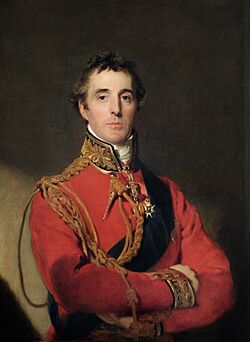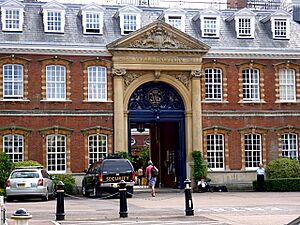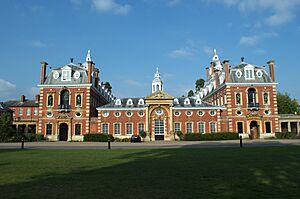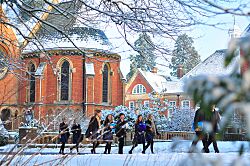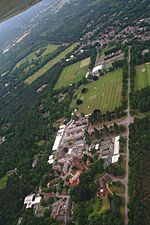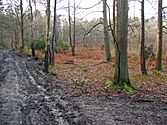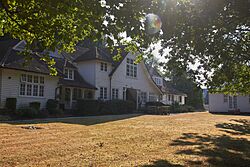Wellington College, Berkshire facts for kids
Quick facts for kids Wellington College |
|
|---|---|
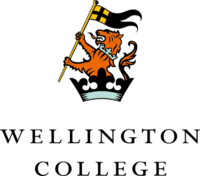 |
|
 |
|
| Address | |
|
Dukes Ride
, Berkshire
,
RG45 7PU
England
|
|
| Coordinates | 51°21′51″N 0°48′24″W / 51.3643°N 0.8067°W |
| Information | |
| Type | Public school Private boarding and day school |
| Motto | Virtutis Fortuna Comes ('Fortune favours the bold') Heroum Filii ('The children of heroes') |
| Religious affiliation(s) | Church of England |
| Established | 1853 |
| Founder | Queen Victoria |
| Department for Education URN | 110125 Tables |
| Chairman of the board of governors |
William Jackson |
| Master | James E. L. Dahl |
| Second Master | Cressida Henderson |
| Staff | 175 (approx.) |
| Gender | Co-educational The school has a 50%-50% split of girls and boys |
| Age | 13 to 18 |
| Enrolment | 1140 pupils |
| Houses | 18 (16 boarding, 2 day) |
| Colour(s) | Yellow Light blue Orange |
| Song | Heroum Filii |
| Publication | The Wellingtonian |
| Alumni | Old Wellingtonians ("OWs") |
| Campus | 400-acre (1.6 km2) rural campus |
| Affiliations | G30 Schools HMC The Rugby Group |
Wellington College is a private school in the United Kingdom. It teaches both boys and girls, offering places for students who live at the school (boarding) and those who travel in each day (day pupils). The school is located in the village of Crowthorne, in Berkshire, England.
Wellington College is a registered charity. It currently teaches about 1,100 students aged between 13 and 18. The school was built to honor the military achievements of the first Duke of Wellington. He was a famous general who defeated Napoleon and later became the British Prime Minister.
The school was officially started by a special document from the King or Queen, called a Royal Charter, in 1853. Queen Victoria laid the first stone in 1856. She officially opened the school to students on January 29, 1859.
Many students from Wellington College fought in the First World War. A large number volunteered for the army right after leaving school. In total, 707 former students died in that war. Another 501 former students were killed in the Second World War.
Wellington College is part of the Rugby Group, which includes 18 well-known British private schools. It is also a member of the G30 Schools group. For the school year 2023/24, the cost for boarding students was about £18,310 per term, or £50,930 for the whole year.
In March 2023, the school received the Artsmark Platinum award from Arts Council England. Since 2020, The Schools Index has listed Wellington College as one of the world's top 150 schools. It is also named one of the top 30 senior schools in the UK.
Contents
History of Wellington College
Wellington College received its royal charter in 1853. It was first called "The Royal and Religious Foundation of the Wellington College." The school officially opened its doors in 1859. Its first headmaster, known as the Master, was Edward White Benson. He later became the Archbishop of Canterbury.
Originally, the school was for the sons of army officers who had passed away. In 1952, a new Royal Charter allowed the sons of deceased officers from the Royal Navy, Royal Marines, and Royal Air Force to attend. By the 1960s, the school thought about allowing girls, but it didn't have enough money at the time.
The first girls joined the school in the Sixth Form (the last two years of high school) in the 1970s. The school became fully co-educational, meaning it accepted both boys and girls in all years, in 2005. Since 2006, the school has offered reduced fees for children of any military service member who passed away. It also helps children whose parents died performing brave acts. However, most students at the school today do not come from military families.

On September 6, 2013, The Week magazine named Wellington College "The Most Forward-Thinking School in the UK." Four days later, Tatler magazine chose Wellington College as the "Best Senior School in Britain." In 2024, Tatler magazine again featured Wellington College. The current Master, James Dahl, was nominated for "Best Head of a Public School."
Wellbeing Classes
In the early 2000s, after some reports about students being bullied, the new Master, Sir Anthony Seldon, started 'wellbeing' classes. Sir Anthony, an author and historian, worked with a team from the University of Cambridge. He believed it was important to help students learn how to be happy and deal with challenges.
The Wellington Academy
Wellington College helped start a new state school in Wiltshire called The Wellington Academy. This school opened in 2009. Sir Anthony Seldon, the former Master of Wellington College, was the one who suggested creating it.
Wellington College International Schools
Wellington College has partnered with schools in other countries. These schools are based on Wellington College's style and values. They include:
- Wellington College International Tianjin in Tianjin, China (opened 2011)
- Wellington College International Shanghai and Huili School Shanghai in Shanghai, China
- Wellington College International Hangzhou and Huili School Hangzhou in Hangzhou, China
- Wellington College International Bangkok in Thailand
- Wellington College International Pune in India
College Architecture
The main buildings of Wellington College were designed by John Shaw, Jr.. He had also worked as an architect for Eton College. The design of Wellington College was quite unique for its time. Prince Albert, who helped choose the architect, liked Shaw's classical style. The main buildings are in a style called "French Grand Rococo."
The school's chapel was designed by Sir Gilbert Scott. It is only half the size it was originally planned to be. Many new buildings have been added over the years. Some of the best new buildings match Shaw's grand rococo style, like the Nicholson modern foreign-languages building. In 2019, the GWA Performing Arts Centre opened. It has a 900-seat auditorium used by students and for fundraising for the Wellington College Arts Fund.
The college has been used as a filming location for the Netflix series The Crown. It stood in for Kensington Palace in seasons 2, 3, 4, and 5.
College Location
Wellington College is located on a 400-acre estate in South-East England. It is near the towns of Reading and Sandhurst. The school grounds include two theaters, a 9-hole golf course, a science building, and a language learning center. There are also large wooded areas, an indoor swimming pool, sports courts, and many playing fields for cricket and rugby.
The grounds also have a special Mandarin language center. It features a pagoda and a Chinese water garden. This center is thought to be the largest of its kind in the UK.
The woodland area of the college is a local nature reserve called Edgbarrow Woods. The grounds also contain a special natural area called Wellington College Bog, which is a Site of Special Scientific Interest (SSSI).
Academic Achievements
In 2024, 66.3% of students at Wellington College achieved A*-A grades in their A-Level exams. Also, 44% of students scored 40 points or more in their IB (International Baccalaureate) exams. In the same year, 65% of students received the highest grades (9 or 8) in their GCSEs.
The average IB score for the College in 2024 was 38.4. The school also had its best ever results for A* grades at A-Level, with 31.7% of grades being A*. More than 20 students achieved three A* grades or better.
Sports at Wellington College
Wellington College was one of the 21 schools that helped create the Rugby Football Union. Students at the school have a long history of playing high-level schoolboy rugby. In 2008, Wellington College made history by winning the Daily Mail Cup at both the Under 15 and Under 18 levels in the same year. They won their finals at Twickenham.
Many former Wellington students play professional rugby union. These include James Haskell (England), Paul Doran-Jones (England), and brothers Max Evans and Thom Evans (Scotland).
The school has one of only about 20 racquets courts in the UK. It also has one of 27 real tennis courts in the UK. Until 2005, it had three Eton Fives courts, which are now a café bar.
Masters of Wellington College

The "Master" is the title for the head of Wellington College. Here is a list of the Masters:
- Since 2019 James E. L. Dahl
- 2015 – 2019 Julian P. Thomas
- 2006 – 2015 Sir Anthony Francis Seldon
- 2000 – 2005 A. Hugh Monro
- 1989 – 2000 Charles Jonathan "Jonty" Driver
- 1979 – 1989 David H. Newsome
- 1966 – 1979 Frank Forman Fisher
- 1956 – 1966 Graham Henry Stainforth
- 1941 – 1956 Harry Wilfred House
- 1937 – 1940 Robert "Bobby" Paton Longden (killed at the College in a bombing raid)
- 1921 – 1937 Frederick Blagden Malim
- 1910 – 1921 William Wyamar Vaughan
- 1893 – 1910 Bertram Pollock
- 1873 – 1893 Edward C. Wickham
- 1859 – 1873 Edward White Benson
Famous Former Students
Many notable people have attended Wellington College. They are known as "Old Wellingtonians" or "OWs." Some of them include:
- Historian P. J. Marshall
- Field marshal Sir Claude Auchinleck
- Squadron leader Roger Bushell (1910-1944), who planned the "Great Escape"
- Military historian Sir Michael Howard
- Clergyman and author David Watson
- Architect Sir Nicholas Grimshaw
- Impressionist Rory Bremner
- Pakistani politician Hammad Azhar
- Adolphus Cambridge, 1st Marquess of Cambridge
- Author Sebastian Faulks
- Playwright Hugh Salmon
- Political journalist Robin Oakley
- Actor Sir Christopher Lee
- Former Mayor of Bristol George Ferguson
- Writer George Orwell (attended briefly in 1917)
- Poet Gavin Ewart
- Composer John Gardner
- World champion motor racing driver James Hunt
- Former Leader of the House of Lords Lord Strathclyde
- Journalist and television presenter, Peter Snow
- The UK Pop Idol winner Will Young
- Revenge actor Josh Bowman
- Singer Nerina Pallot
- Rugby Union players, James Haskell and the brothers Max and Thom Evans
- Actor Robert Morley
- Actress Caggie Dunlop
- Actress Elize du Toit
- Actress Ellie Bamber
- Olympic athlete Morgan Lake
- Michael Knatchbull, 5th Baron Brabourne
- Soros family
- Getty family
- de Betak family
- de Givenchy family
- Prince Christian Victor of Schleswig-Holstein
- Prince Maurice of Battenberg
- Alexander Mountbatten, 1st Marquess of Carisbrooke
- Count Nikolai Tolstoy
- Princess Maria-Olympia of Greece and Denmark
- Prince Constantine Alexios of Greece and Denmark
- Prince Achileas-Andreas of Greece and Denmark
- Prince Odysseas-Kimon of Greece and Denmark
- Formula One Engineer Patrick Head
- Cricketer Tom Curran
- Cricketer Sam Curran
School Houses
Wellington College has 18 different "houses." A house is like a smaller community within the school. Most houses are for boarding students, but two, Wellesley and Raglan, are for day students only. Some houses are inside the main school buildings ("in-houses"), while others are in separate buildings on the school grounds ("out-houses").
Each house has its own special colors, symbols, and crest. The crest of each house is even shown in the stained glass windows of the college chapel. Each house is named after an important historical figure, often someone connected to the Duke of Wellington.
| House | Colours | Insignia | Gender | Boarding or Day | Named after |
|---|---|---|---|---|---|
| Anglesey | Maroon and Blue | A Star | F | Boarding | Henry Paget, 1st Marquess of Anglesey |
| Apsley | Blue and Black | A Pineapple | F | Boarding | Apsley House |
| Benson | Blue and Silver | A Rose | M | Boarding | Edward White Benson |
| Beresford | Medium Blue and Black | A Horseshoe | M | Boarding | William Beresford, 1st Viscount Beresford |
| Blücher | Black and White | A Fleur-de-lis | M | Boarding | Gebhard Leberecht von Blücher, Prince of Wahlstatt |
| Combermere | Gold and Brown | A Lion | F | Boarding | Stapleton Cotton, 1st Viscount Combermere |
| Elizabeth | Gold and Red | A Crown | M & F | Boarding (Sixth Form only) | Elizabeth II |
| Hardinge | Green and Brown | An Anchor | F | Boarding (No Third Form) | Henry Hardinge, 1st Viscount Hardinge |
| Hill | Purple and White | A Skull and Crossbones | M | Boarding | Rowland Hill, 1st Viscount Hill |
| Hopetoun | Yellow and Blue | A Moon and Star | F | Boarding | John Hope, 4th Earl of Hopetoun |
| Lynedoch | Navy Blue and Black | An Iron Cross | M | Boarding | Thomas Graham, 1st Baron Lynedoch |
| Murray | Purple and Black | A Moon | M | Boarding | Sir George Murray |
| Orange | Orange and Black | A Double-headed Eagle | F | Boarding | William, Prince of Orange, later William II of the Netherlands |
| Picton | Pink and Brown | An Eagle | M | Boarding | Sir Thomas Picton |
| Raglan | Red and Grey | A Panther | M | Day | FitzRoy Somerset, 1st Baron Raglan |
| Stanley | Maroon and Light Blue | A Unicorn | M | Boarding | Edward Smith-Stanley, 14th Earl of Derby |
| Talbot | Maroon and White | A Maltese Cross | M & F | Boarding | Sir Wellington Patrick Talbot |
| Wellesley | Pink and White | A Pelican | F | Day | Arthur Wellesley, 2nd Duke of Wellington |
Some houses that used to be for boys, like Orange, Combermere, Hopetoun, and Anglesey, changed to girls' houses between 2005 and 2011. The Talbot house is currently changing from a boys' to a girls' house.
The Old Wellingtonian Society
The Old Wellingtonian Society is a group for former students of Wellington College. It was started in 1890. The society helps keep former students connected with each other and with the school. It also works to support the college's interests.
See also
- List of notable Old Wellingtonians
- Category:People educated at Wellington College, Berkshire
- Wellington College International Shanghai, a subsidiary school in China
- Wellington College International Tianjin, a subsidiary school in China


